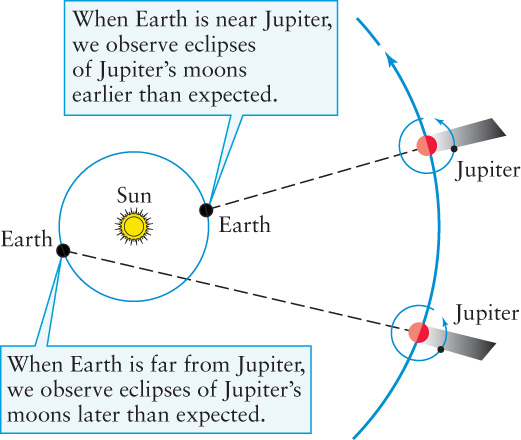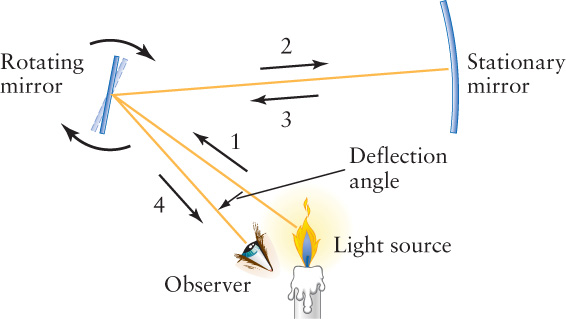5-1 Light travels through empty space at a speed of 300,000 km/s
The speed of light in a vacuum is a universal constant: It has the same value everywhere in the cosmos
Galileo Galilei and Isaac Newton were among the first scientific thinkers to ask basic questions about light. Does light travel instantaneously from one place to another, or does it move with a measurable speed? Whatever the nature of light, it does seem to travel swiftly from a source to our eyes. We see a distant event before we hear the accompanying sound. (For example, we see a flash of lightning before we hear the thunderclap.)
In the early 1600s, Galileo tried to measure the speed of light. He and an assistant stood at night on two hilltops a known distance apart, each holding a shuttered lantern. First, Galileo opened the shutter of his lantern; as soon as his assistant saw the flash of light, he opened his own. Galileo used his pulse as a timer to try to measure the time between opening his lantern and seeing the light from his assistant’s lantern. From the distance and time, he hoped to compute the speed at which the light had traveled to the distant hilltop and back.
Galileo found that the measured time failed to increase noticeably, no matter how far away the assistant was stationed. Galileo therefore concluded that the speed of light is too high to be measured by slow human reactions. Thus, he was unable to tell whether or not light travels instantaneously.
The Speed of Light: Astronomical Measurements
The first evidence that light does not travel instantaneously was presented in 1676 by Olaus Rømer, a Danish astronomer. Rømer had been studying the orbits of the moons of Jupiter by carefully timing the moments when they passed into or out of Jupiter’s shadow. To Rømer’s surprise, the timing of these eclipses of Jupiter’s moons seemed to depend on the relative positions of Jupiter and Earth. When Earth was far from Jupiter (that is, near conjunction; see Figure 4-6), the eclipses occurred several minutes later than when Earth was close to Jupiter (near opposition).
Rømer realized that this puzzling effect could be explained if light needs time to travel from Jupiter to Earth. When Earth is closest to Jupiter, the image of one of Jupiter’s moons disappearing into Jupiter’s shadow arrives at our telescopes a little sooner than it does when Jupiter and Earth are farther apart (Figure 5-1). The range of variation in the times at which such eclipses are observed is about 16.6 minutes, which Rømer interpreted as the length of time required for light to travel across the diameter of Earth’s orbit (a distance of 2 AU). The size of Earth’s orbit was not accurately known in Rømer’s day, and he never actually calculated the speed of light. Today, using the modern value of 150 million kilometers for the astronomical unit, Rømer’s method yields a value for the speed of light equal to roughly 300,000 km/s (186,000 mi/s).

The Speed of Light: A Universal Speed Limit
Almost two centuries after Rømer, the speed of light was measured very precisely using an ingenious experiment. In 1850, the French physicists Armand-Hippolyte Fizeau and Jean Foucault built the apparatus sketched in Figure 5-2. Light from a light source reflects from a rotating mirror toward a stationary mirror 20 meters away. The rotating mirror moves slightly while the light is making the round trip, so the returning light ray is deflected away from the source by a small angle. By measuring this angle and knowing the dimensions of their apparatus, Fizeau and Foucault could deduce the speed of light. Once again, the answer was very nearly 300,000 km/s. Based on modern measurements, whether measuring the speed of light on Earth, in the solar system, or amongst galaxies, the speed of light appears to be the same throughout the known universe.

The speed of light in a vacuum (a space devoid of matter) is usually designated by the letter c (from the Latin celeritas, meaning “speed”). The modern value is c = 299,792.458 km/s (186,282.397 mi/s). In most calculations you can use
c = 3.00 × 105 km/s = 3.00 × 108 m/s
The most convenient set of units to use for c is different in different situations. The value in kilometers per second (km/s) is often most useful when comparing c to the speeds of objects in space, while the value in meters per second (m/s) is preferred when doing calculations involving the wave nature of light (which we will discuss in Section 5-2).
The speed of light is extremely fast. In one second, light travels a distance equal to about 7½ times around Earth’s equator! Since there are more than 31 million seconds in a year, one light-year—the distance light travels in one year—is about 6 trillion miles.
CAUTION!
Note that the quantity c is the speed of light in a vacuum. Light travels more slowly through air, water, glass, or any other transparent substance than it does in a vacuum. In our study of astronomy, however, we will almost always consider light traveling through the vacuum (or near-vacuum) of space.
The speed of light in empty space is one of the most important numbers in modern physical science. This value appears in many equations that describe atoms, gravity, electricity, and magnetism. According to Einstein’s special theory of relativity, there is a universal speed limit: Nothing can travel faster than the speed of light.
CONCEPT CHECK 5-1
Why has the speed of light historically been so difficult to measure?
The speed of light is incredibly fast, which made it very difficult to measure light’s speed except over enormous distances.